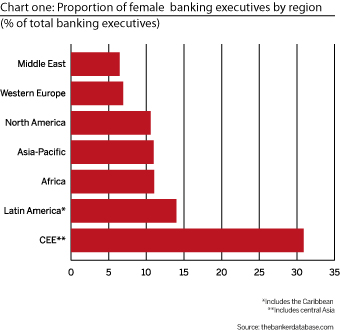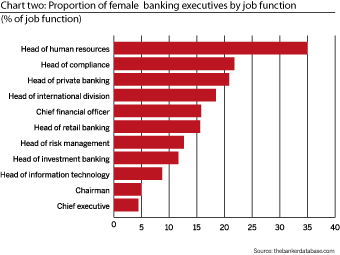In September 2012, the European Commission proposed mandatory requirements for European companies to appoint women to at least 40% of non-executive directorships. The hope is that by increasing the presence of women in the boardroom, this will feed through to greater female representation in the upper echelons of the corporate world in general.
In the UK, a pressure group called the 30% Club is urging a voluntary approach. In response to the EU consultation on the subject, it points to a four-percentage-point increase in the proportion of women on the boards of the UK’s top 100 listed companies, to 16%, since the club’s creation in November 2010.
According to the 30% Club letter, “the nature of the debate in the UK’s largest companies has shifted from ‘why is this important?’ to ‘how do we achieve change?’". But the financial sector may well be behind the curve. In fact, out of the 168 senior managers at UK banks listed in The Banker Database, only 9.49% are women.
The database lists the names of more than 14,000 banking executives and directors worldwide, including chairmen, chief executives, chief financial officers, and heads of business functions such as risk, retail banking, investment banking and technology. Western Europe as a whole performs particularly badly, with women comprising just 6.9% of bank executives. This is despite the best efforts of Finland (20%) and Iceland (21.7%).
The only region where the ratio is lower is in the Middle East (6.4%), where several countries have legal restrictions on female employment and property rights. The Middle East score is boosted by Israel, where women account for 26.9% of bank executives. While the absence of women among the executives of Saudi Arabian banks may not come as a surprise, Liechtenstein, also with no women, may have some explaining to do. Switzerland is little better, with just 2.6%, while Ireland has just 3%.
Elsewhere, women among the managers of banks in Japan and South Korea are exceptionally rare, at 0.7% and 1.7%, respectively. By contrast, women comprise 33.6% of executives in Vietnam. The US is fractionally behind the UK, and less than half the 20% level in Canada.
However, there is one region that already meets the 30% target. The Soviet bloc may not have achieved economic equality, but it certainly seems to have gone a long way toward creating gender equality in bank boardrooms. The average for central and eastern Europe (including central Asia) is 30.9%, with women actually in the majority in Macedonia (56.4%). In another eight countries, women hold more than 40% of bank management posts. The only other countries where women exceed 50% of posts are Jamaica and Dominica in the Caribbean.
Things are clearly tough at the top for women, with chief executives and chairmen the rarest roles for women to hold. Women are also under-represented as heads of information technology, and over-represented as heads of human resources, but perhaps the relatively high occurrence of female chief financial officers (15.8%, compared with an average of 13.3% across all job functions) is more of a departure from gender stereotypes.








